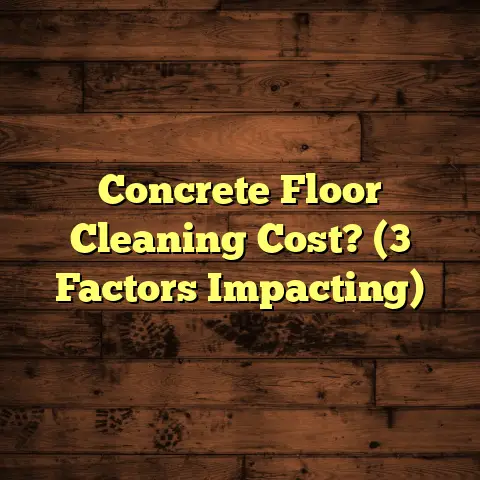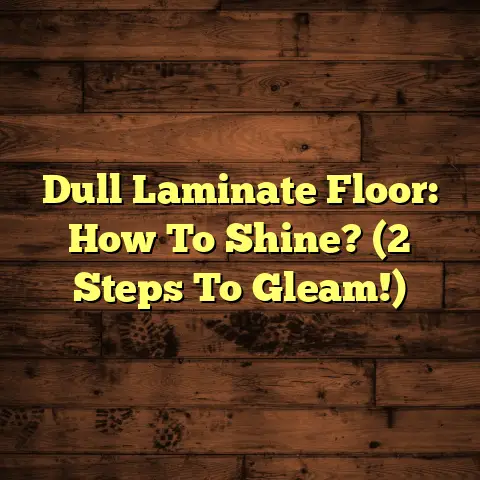Mold Under Wood Floors (6 Steps To Fix Fast!)
Let’s talk about something nobody wants to deal with: mold under wood floors.
Trust me, as a flooring contractor for over 15 years, I’ve seen it all, and it’s never pretty.
Imagine this…
Before:
You walk into your living room, and there’s this unmistakable musty smell hanging in the air.
You try to ignore it, but then you notice dark spots creeping along the edges of your beautiful hardwood.
Your heart sinks.
You know what it is: mold.
Your beautiful floors, the ones you invested so much in, are now a potential health hazard.
Frustration and a bit of panic set in. Where do you even start?
After:
Fast forward a few weeks.
You step onto your gleaming, revitalized wood floors.
The musty odor is gone, replaced by the fresh, clean scent of a healthy home.
You can finally breathe easy, knowing you’ve tackled the mold issue head-on.
The air feels cleaner, and there’s a sense of relief and accomplishment.
You walk barefoot, feeling the smooth, solid surface beneath your feet, confident that your home is safe and beautiful once again.
Sound good?
Let’s get to it!
Section 1: Understanding Mold
So, what exactly is mold?
Well, it’s a type of fungus that thrives in damp, dark, and poorly ventilated environments.
Think of it as nature’s recycler, breaking down organic matter.
While that’s great in the forest, it’s not so great under your wood floors.
Why Wood Floors?
Wood is an organic material, which makes it a perfect food source for mold.
Add in moisture from leaks, high humidity, or even just poor ventilation, and you’ve got a recipe for disaster.
I’ve seen it happen time and time again.
A small plumbing leak under a sink goes unnoticed, and before you know it, mold is spreading like wildfire.
Common Types of Mold:
There are tons of different types of mold, but some of the most common ones I see in homes include:
-
Aspergillus: Often found in damp areas, it can cause allergic reactions and respiratory problems.
-
Cladosporium: This one is pretty hardy and can grow on both wood and fabrics.
-
Penicillium: Yep, the same one that gives us penicillin! But in your home, it’s not so helpful.
-
Stachybotrys chartarum (Black Mold): The infamous black mold. While not always as dangerous as people think, it can produce toxins that cause serious health issues.
Health Risks:
Speaking of health, mold exposure can cause a range of problems, especially for people with allergies, asthma, or compromised immune systems.
I’m talking:
- Sneezing
- Coughing
- Runny nose
- Skin rashes
- Headaches
- Respiratory infections
In severe cases, it can even lead to more serious conditions.
That’s why it’s so important to address mold issues quickly and effectively.
The Bottom Line:
Mold under wood floors isn’t just an aesthetic problem. It’s a health hazard that needs to be taken seriously.
Section 2: Identifying Mold Under Wood Floors
Okay, so how do you know if you have mold lurking beneath your beautiful floors?
Here are some telltale signs I’ve learned to look for:
-
Musty Odor: This is usually the first clue. If you notice a persistent musty smell in a room, especially one with wood floors, it’s time to investigate.
-
Visible Discoloration: Keep an eye out for dark spots, patches, or stains on your wood floors. These can be signs of mold growth.
-
Warped or Buckling Floorboards: When wood gets wet, it expands. If you see your floorboards warping or buckling, it could mean there’s moisture underneath, which can lead to mold.
-
Allergic Reactions: Are you suddenly experiencing more allergy symptoms than usual? Mold could be the culprit.
The Inspection Process:
Alright, time to put on your detective hat!
-
Start with the Obvious: Check around sinks, toilets, showers, and any other areas prone to water leaks.
-
Basements and Crawl Spaces: These are prime breeding grounds for mold. Look for signs of moisture or water damage.
-
Check Under Rugs: Rugs can trap moisture, creating a perfect environment for mold growth. Lift them up and take a peek.
-
Peel Back the Edges: If you suspect mold along the edges of your floor, carefully peel back the baseboards or trim to get a better look.
A Word of Caution:
If you find mold, don’t panic! But do take it seriously. Avoid disturbing the mold too much, as this can release spores into the air.
Tools of the Trade:
Here are a few tools that can help with your inspection:
- Flashlight: For peering into dark corners.
- Moisture Meter: To measure the moisture content of your wood floors and subfloor.
- Screwdriver: For removing baseboards or trim.
- Camera: To document any evidence of mold.
Pro Tip:
If you’re not comfortable doing the inspection yourself, don’t hesitate to call in a professional.
A qualified mold inspector can identify hidden mold problems and recommend the best course of action.
Section 3: Safety Precautions Before Starting the Fix
Before you start ripping up your floors and tackling the mold head-on, it’s crucial to take some safety precautions.
Mold spores can be harmful, and you want to protect yourself and your family.
Personal Protective Equipment (PPE):
Think of PPE as your mold-fighting armor. Here’s what I recommend:
-
Gloves: Wear waterproof gloves to protect your skin from mold and cleaning solutions.
-
Mask: A N-95 or P-100 respirator mask is essential to prevent you from inhaling mold spores.
-
Goggles: Protect your eyes from splashes and airborne particles.
-
Tyvek Suit (Optional): For larger mold infestations, a disposable Tyvek suit can provide full-body protection.
Ventilation is Key:
Mold loves stagnant air, so good ventilation is crucial.
-
Open Windows and Doors: If possible, open windows and doors to create a cross-breeze.
-
Use Fans: Place fans in the room to circulate the air.
-
Consider a HEPA Air Purifier: A HEPA air purifier can help remove mold spores from the air.
Containment:
To prevent mold spores from spreading to other areas of your home, it’s a good idea to create a containment zone.
-
Seal Off the Area: Use plastic sheeting and painter’s tape to seal off the affected area from the rest of the house.
-
Cover Air Vents: Cover any air vents in the room to prevent spores from entering your HVAC system.
Cleaning Supplies:
Make sure you have all your cleaning supplies on hand before you start. I’ll go into more detail about specific cleaning solutions in the next section.
A Word of Caution:
If you have a large mold infestation (more than 10 square feet), or if you’re particularly sensitive to mold, it’s best to call in a professional mold remediation company.
They have the expertise and equipment to safely and effectively remove the mold.
Section 4: The 6 Steps to Fix Mold Under Wood Floors
Alright, let’s get down to business!
Here are the six steps I use to fix mold under wood floors:
Step 1: Identify and Fix the Source of Moisture
This is the most crucial step.
If you don’t fix the source of moisture, the mold will just keep coming back.
-
Check for Leaks: Inspect plumbing, roofs, windows, and any other areas that could be leaking.
-
Address Humidity: If high humidity is the problem, consider using a dehumidifier to lower the moisture level in your home.
-
Improve Ventilation: Make sure your home is properly ventilated, especially in bathrooms and kitchens.
Step 2: Remove Affected Flooring
Now it’s time to remove the moldy wood flooring.
-
Gather Your Tools: You’ll need a pry bar, hammer, screwdriver, and safety glasses.
-
Carefully Remove the Flooring: Start by removing the baseboards or trim around the edges of the room. Then, use the pry bar to carefully remove the affected floorboards.
-
Bag and Dispose of the Moldy Material: Place the moldy flooring in heavy-duty plastic bags and seal them tightly. Dispose of the bags properly according to your local regulations.
Step 3: Clean the Area
Once you’ve removed the moldy flooring, it’s time to clean the area.
-
Vacuum with a HEPA Filter: Use a vacuum cleaner with a HEPA filter to remove any loose mold spores.
-
Scrub with a Mold-Killing Solution: There are several effective mold-killing solutions you can use:
- Bleach Solution: Mix one part bleach with ten parts water. Be careful when using bleach and always wear gloves and eye protection.
- Vinegar: Vinegar is a natural mold killer. Simply spray it on the affected area and let it sit for an hour before wiping it clean.
- Commercial Mold Killer: There are many commercial mold killers available at your local hardware store. Follow the instructions on the label carefully.
-
Scrub Thoroughly: Use a scrub brush to thoroughly clean the subfloor and any surrounding areas.
Step 4: Treat the Subfloor
After cleaning, it’s important to treat the subfloor to prevent mold from returning.
-
Apply a Mold Inhibitor: Apply a mold inhibitor to the subfloor according to the manufacturer’s instructions.
-
Let it Dry Completely: Allow the mold inhibitor to dry completely before moving on to the next step.
Step 5: Allow for Proper Drying
Moisture is mold’s best friend, so it’s crucial to dry the area thoroughly.
-
Use Dehumidifiers and Fans: Place dehumidifiers and fans in the room to remove moisture from the air.
-
Monitor Moisture Levels: Use a moisture meter to monitor the moisture content of the subfloor. You want it to be below 16% before you replace the flooring.
Step 6: Replace or Repair Flooring
Once the area is clean, treated, and dry, you can replace or repair the flooring.
-
Install New Flooring: If the old flooring was too damaged to be salvaged, install new flooring.
-
Repair Existing Flooring: If the damage was minor, you may be able to repair the existing flooring.
-
Seal the Flooring: Seal the new or repaired flooring to protect it from moisture.
Section 5: Long-Term Prevention Strategies
Okay, you’ve tackled the mold issue.
Now, how do you keep it from coming back?
Here are some long-term prevention strategies I recommend:
-
Maintain Indoor Humidity Levels: Keep your indoor humidity levels between 30% and 50%. Use a dehumidifier if necessary.
-
Ensure Proper Ventilation: Make sure your home is properly ventilated, especially in bathrooms and kitchens. Use exhaust fans when showering or cooking.
-
Regular Inspections: Regularly inspect your home for signs of leaks or water damage. Pay close attention to areas around plumbing, windows, and roofs.
-
Clean Gutters Regularly: Clogged gutters can cause water to back up and leak into your home. Clean your gutters at least twice a year.
-
Use Mold-Resistant Materials: When renovating or remodeling, use mold-resistant materials whenever possible.
-
Address Leaks Promptly: Don’t ignore leaks! Even small leaks can lead to mold growth. Fix them as soon as possible.
-
Consider a Vapor Barrier: If you have a crawl space, consider installing a vapor barrier to prevent moisture from seeping into your home.
Conclusion
Dealing with mold under wood floors can be a daunting task, but it’s definitely something you can tackle with the right knowledge and tools.
Remember, the key is to identify and fix the source of moisture, clean and treat the affected area, and take steps to prevent mold from returning.
Don’t underestimate the importance of addressing mold promptly.
The longer you wait, the worse the problem will become.
By taking proactive measures to maintain your home and address any moisture issues, you can create a safe and healthy living environment for yourself and your family.
And trust me, there’s nothing quite like the peace of mind that comes from knowing you’ve taken care of a problem like this. You got this!





